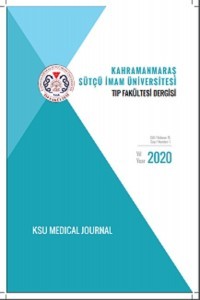Akut Pankreatitin Şiddetini Öngörmede Yatak Başı Akut Pankreatit Şiddet İndeks Skoru ile APACHE II Skorunun Karşılaştırılması
AMAÇ: AP pankreasın akut inflamatuar bir hastalığıdır. Hastaların çoğunda hafif seyrederken, yaklaşık %10-20’sinde şiddetli seyredip ciddi morbidite ve mortalite riski taşır. Şiddetli AP hastalarının, uygun merkezlerde ve gereğinde yoğun bakım ünitelerinde yapılan erken agresif tedavisi ile morbidite ve mortalite düşürülebilmekte olup AP şiddetini erken ve güvenilir bir şekilde ön görebilmek önemlidir. GEREÇ VE YÖNTEMLER: Bu çalışmada, AP şiddetini öngörmede BISAP skoru ile APACHE II skorunun karşılaştırılması amaçlandı. Bu amaçla mart 2015 - temmuz 2016 arasında tedavi ettiğimiz 86 AP hastası çalışmaya alındı. Hastaların ortalama yaşı 52,33 olup 48’i (%55,8) kadındı. Revize Atlanta kriterlerine göre 58 (%67,4) hastada hafif, 20 (%23,3) hastada orta şiddette ve 8 (%9,3) hastada şiddetli AP saptandı. Şiddetli AP olan bir hasta eksitus oldu. Genel mortalite %1,16 ve şiddetli AP için mortalite %12,5 idi. BULGULAR:Hastalar başvuruda, 24. saat ve 48. saatte APACHE II ve ilk 24 saatte BISAP skorlaması ile değerlendirildi. BISAP skorlamasında ≥2 olan 11 (%12,8) hastanın 5’i (%45,45) şiddetli AP, 5’i orta şiddette AP ve 1’ide (%9,09) hafif AP idi. BISAP skoru <2 olan 75 hastanın ise sadece 3’ünde (%4) şiddetli AP saptandı. Başvuruda APACHE II skoru ≥8 olan 9 (%10,5) hastanın 6’sı (%66,7) şiddetli AP, 3’ü ise orta şiddette AP idi. Skoru <8 olan 77 hastanın ise sadece 3’ünde (%2,6) şiddetli AP saptandı. 24. ve 48. saat APACHE II skoru ≥8 olan 4 hastanın (%4,7) tamamı şiddetli AP idi. Şiddetli AP gelişmesinin BISAP ile öngörülmesinde duyarlılık %62,50; özgüllük % 92,31; pozitif prediktif değer %45,45 ve negatif prediktif değer %96 olarak saptandı. Şiddetli AP gelişmesinin APACHE II ile öngörülmesinde; başvurudaki APACHE II için duyarlılık %75; özgüllük % 96,15; pozitif prediktif değer %66,67 ve negatif prediktif değer %97,40 iken 24. saat ve 48. saat APACHE II için duyarlılık %50; özgüllük % 100; pozitif prediktif değer %100 ve negatif prediktif değer %95,12 olarak saptandı. SONUÇLAR: Çalışmamızda AP’in şiddetini öngörmede BISAP skorlaması ile gerek başvuruda gerekse 24. ve 48. saat APACHE II skorlamaları arasında istatistiksel anlamlı pozitif korelasyon saptandı. Etkinlikleri değerlendirildiğinde de benzer doğrulukta oldukları görüldü. Sonuç olarak; BISAP skorlamasının AP şiddetini öngörmede, uygulaması zor ve karmaşık bir yöntem olan APACHE II skorlaması yerine daha kolay ve basit bir yöntem olarak uygulanabileceğini düşünmekteyiz.
AKUT PANKREATİTİN ŞİDDETİNİ ÖNGÖRMEDE YATAK BAŞI AKUT PANKREATİT ŞİDDET İNDEKS SKORU İLE APACHE II SKORUNUN KARŞILAŞTIRILMASI
OBJECTIVES: AP is an inflammatory disease of the pancreas. Although it has a mild course in the majority of cases, it causes severe symptoms and carries a serious morbidity and mortality risk in 10-20% of patients. Fortunately, mortality and morbidity of severe AP cases can be reduced by early aggressive treatment at appropriate centers and at intensive care units whenever necessary. To achieve that goal, it is of utmost importance to reliably predict AP severity early in the course. MATERIALS AND METHODS: In the present study it was aimed to compare the predictive abilities of BISAP and APACHE II scores for AP severity. For this purpose, we enrolled 86 AP patients treated between March 2015 and July 2016. The study population had a mean age of 52.33 years, and 48 (55.8%) patients were women. According to the revised Atlanta criteria, 58 patients (67.4%) had mild AP, 20 (23.3%) had moderately severe AP, and 8 (9.3%) had severe AP. One patient with severe AP died. The overall mortality was 1.16%, and the mortality rate associated with severe AP was 12.5%. RESULTS: The patients were evaluated with the APACHE II score at admission, at 24 hours, and at 48 hours; BISAP scoring was used within 48 hours. Five (45.45%) of 11 (12.8%) patients with a BISAP score of ≥2 had severe AP, 5 had moderately severe AP, and 1 (9.09%) had mild AP. Only 3 (4%) of 75 patients with a BISAP score of <2 had severe AP. Six (66.7%) of 9 (10.5%) patients with an admission APACHE II score of ≥8 had severe AP and 3 had moderately severe AP. Of 77 patients with a score of <8, only 3 (2.6%) had severe AP. All of 4 (4.7%) patients with 24- and 48-hour APACHE II scores of ≥8 had severe AP. BISAP had a sensitivity of 62.5%, specificity of 92.31%, positive predictive value of 45.45%, and negative predictive value of 96% for severe AP. The corresponding figures for the admission APACHE II score were 75%, 96.15%, 66.67%, and 97.40%, respectively. At 24 and 48 hours, APACHE II score had a sensitivity of 50%, specificity of 100%, positive predictive value of 100%, and negative predictive value of 95.12%. CONCLUSIONS: A statistically significant positive correlation was found between the BISAP score and admission, 24-hour, and 48-hour APACHE II score. Both scoring systems also had similar effectiveness.In conclusion, we believe that the BISAP scoring system may be utilized as a simpler and easier-to-use method than the more complex and difficult-to-use APACHE II scoring system for the prediction of AP severity.
___
- 1.Vasudevan, S., Goswami, P., Sonika, U., Thakur, B., Sreenivas, V., & Saraya, A. (2018). Comparison of Various Scoring Systems and Biochemical Markers in Predicting the Outcome in Acute Pancreatitis: Pancreas, 47(1), 65-71.
2.Zhou, H., Mei, X., He, X., Lan, T., & Guo, S. (2019). Severity stratification and prognostic prediction of patients with acute pancreatitis at early phase. Medicine, 98(16)
